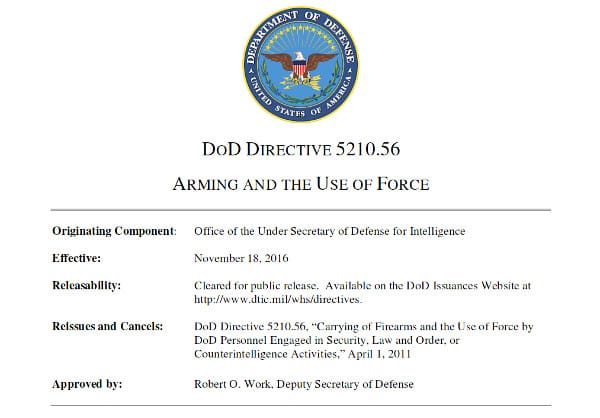Donald Trump promised to eliminate gun free zones in the military and at recruitment centers on day one of his presidency. On November 18th, the Department of Defense released DoD Directive 5201.56. Deputy Secretary of Defense, Robert O. Work, issued the directive on Arming and the Use of Force, that superficially does away with “Gun Free Zones.”
It allows commanders at the O-5 level and above to grant people the authority to carry private defensive weapons. O-5 is a Lieutenant Colonel (LTC) for the Army, Air Force, and Marines; Commander (CDR) for the Navy and Coast Guard. Not all O-5 officers have the authority; only commanders of units, installations or other organizations do. A military commander is a specific position.
Not all officers are commanders. An officer who takes a command position has many special responsibilities and privileges. They stay with the position when another officer takes his place.
The directive is highly restrictive, but it allows for authorizeed DoD personnel to carry personal, privately owned defensive weapons. From dtic.mil:
4.1. GENERAL.
This section provides guidance for determining the eligibility of DoD personnel to carry privately owned firearms on DoD property for personal protection when it is not related to the performance of official duties. This section also provides requirements for individual training, transport, safeguarding, and storage of privately owned firearms that the arming authority must consider when determining whether to permit an individual to carry a privately owned firearm on DoD property.
The directive contains a great may restrictions. There are so many, the directive is almost, but not quite useless.
Each permit holder must be individually approved by the commander involved. That takes a lot of the commander’s valuable time. There are plenty of reasons for commanders to turn down requests en masse, and no incentives given to commanders to approve requests.
The first restriction does much to gut any effective numbers of personnel carrying defensive weapons. It’s unlikely that there will be many DoD personnel that won’t routinely enter federal buildings. It requires that the Commander determine, after consultation with legal counsel, that an exception under 930(d) of Title 18, U.S.C. applies. From the directive:
a. May grant permission to DoD personnel requesting to carry a privately owned firearm (concealed or open carry) on DoD property for a personal protection purpose not related to performance of an official duty or status. Permissions granted under this section do not apply to carrying a firearm within federal buildings unless the arming authority specifically determines, after consultation with servicing legal counsel and in accordance with applicable DoD policy, that an appropriate exception under Section 930(d) of Title 18, U.S.C. applies.
Here is 930(d) of Title 18, U.S.C.:
(d) Subsection (a) shall not apply to—
(3) the lawful carrying of firearms or other dangerous weapons in a Federal facility incident to hunting or other lawful purposes.
Commanders are caught in a sort of legal bind here. They are being required to have legal counsel tell them that one of the three exceptions applies. But the directive itself could easily be interpreted to suffice for exceptions (2) and (3), especially if the person applying has a concealed carry permit.
Carrying a weapon for defense of self and others, and especially with a permit, is a lawful purpose in all U.S. territory. Carrying a weapon after being authorized to do so by a U.S. military commander, is also a lawful purpose.
The directive could have stated that the directive itself meets exceptions (2) and (3), thus taking the burden from individual commanders.
Some other restrictions:
– Personnel authorized must be 21 years of age or older
– Personnel not subject to *any* past or pending personnel action<
– When permitted to carry concealed, the firearm must be completely concealed, and not interfere with normal duties
– May not carry while under the influence of alcohol or other intoxicants
The directive can be significantly improved. The finding of lawful exceptions to 930(d) of Title 18, U.S.C. should be included in the directive, relieving individual commanders of that burden. Commanders should be given incentives to authorize defensive carry. Such an incentive might be:
If an applicant who has a valid concealed carry permit is refused by the authorizing authority, a written explanation of the reason for refusal shall be given to the applicant. Applicants that are refused may appeal the refusal to the Inspector General of the organization.
This directive was put into effect 10 days after the election of Donald Trump. That indicates the Department of Defense takes President elect Trump’s (and future Commander in Chief) promises seriously. If you want a policy done on your terms, one of the most effective ways to obtain it is to present it as already accomplished.
President Trump will be well informed of such tactics. I expect his administration will make appropriate improvements.
©2016 by Dean Weingarten: Permission to share is granted when this notice and link are included. Link to Gun Watch






“Not all officers are commanders.”
Somewhat unfriendly humor and off color jokes inbound, your pos.
“May not carry while under the influence of alcohol or other intoxicants”
Makes sense. If I was a recruiter I’d be drunk most of the time.
This ought to set Obama’s short hairs on fire.
Not really. It’s a textbook example of how to follow orders without actually doing what you were ordered to do.
In simple organizations with few levels of management, the top man is close enough to the lowest grunt to have a good idea whether his orders are being implemented. As complexity and levels increase, it becomes easier for a manager (or officer) part way down the chain of command to subvert or simply ignore orders he dislikes. Chances are the top man will never find out.
I used to work at a large company in which the prime virtue was doing as you were told regardless of adverse consequences for the company. The board of directors brought in an outside CEO who started telling employees to bypass their boss if the boss wouldn’t get with the program. Middle management hated his guts.
Not really. The last NDAA, signed by Obama, authorized this change with the carrying of POW (personally owned weapons). It directed the Secretaries of each branch to work with the DOD to create a policy that would accommodate the NDAA writing. He knew what he was signing.
“Applicants that are refused may appeal the refusal to the Inspector General of the organization.”
I can appreciate the thought, but as a former Army Assistant IG I assure you that’s a pretty much a toothless incentive. The IG will only opine if the commander followed the directive and any implementing reg or not. And if the commander didn’t, the IG will only advise the commander of the error or perhaps refer the matter to the higher level commander for his/her consideration if it is an outright refusal to follow the directive/reg. Other services IG may operate differently.
Could you suggest some other language? The directive could use the word “shall” instead of “may” to require issue. Or perhaps allow only a certain defined set of reasons for refusal. Suggestions welcome.
Dean, at the heart of Outward’s comment is the realization and knowledge that the Inspector General does not tell a Commander what to do. An Inspector General can only advise the command and on actions that they could or should take. They have absolutely no teeth whatsoever in the matter.
What you have suggested with the comment about specific denial criteria is a very good suggestion, but if a commander will ignore a person’s natural right to self-defense he or she would probably ignore that as well.
Commanders frequently ignore regulations that they are required to follow through prioritization or apathy or because they just do not know.
I commented on the last article about this particular policy, this policy is without merit entirely because it does not tell a Commander that he or she must do something. It is (as was mentioned in this article) a useless tool to stave off potential Donald Trump actions on this front.
Troops dont get to freely exercise the 1st ammendment, what makes you think they will be allowed to exercise the 2nd?…… and yes,…. ALLOWED….. they are indentured servents of the state. I was active duty infantry Marine for 4 years (pre 9/11). Indentured servitude is the closest definition of the enlistment contract. I liked/enjoyed my time in, but it is what it is.
I hadn’t thought of it that way, but that sounds about right. I recall a bud and I getting into a discussion once, we had no Active Duty Service Commitment at the time, could we just quit and walk out? The answer was no, but nobody could actually tell us why. Essentially, we could apply for discharge, which would be approved, but would take time to process, and I don’t mean the “2 weeks notice” we’d expect in civilian life. Not a complaint, really, but as you say, “it is what it is”. We were in a position where we needed to be replaced before we could leave or our tiny unit could not do its job. And in order to replace us, new guys would have to go through a 3-month course. Indentured servants? Yeah, not too far off.
Nothing is being said about civilians or retirees, such as me, coming on base with a concealed firearm
This is the part that bothers me. As a retired officer, with over 25 years served, I am still banned from carrying while on base. If I am out running errands, I am expected to go home and disarm before going on post to run errands there.
It also does nothing to permit military spouses the right to exercise their right to self-defense.
I’d settle for being allowed to have unloaded/cased firearms in my car during the day.
I dug a little deeper on this, as an active duty servicemember myself, and discovered the following that still makes it impractical. Has to be reviewed and renewed every 90 days, and you have to have a clear justification to carry I.e. You are in immediate personal danger. Carry as a lifestyle choice doesn’t seem to be an option as it is worded. Still though, baby steps…..
Read it closely. It’s a convoluted approval system, and the default appears to still be denial of CCW.
That’s a feature, not a bug.
I am active duty and attempted to begin the process. I was told it’s not going to happen and don’t even bother since where I work (5 sided building) we have “plenty of security”….. along with the “why do you need to carry a gun during your drive/on the bus/on the train” questions from several. I have a CCW and, honestly, it’s not that I really want or feel a need to carry a gun in the 5 sided building, I just want to be able to carry to/from work where I do feel a need and not have to worry about securing before walking into the building.
Oh well, just another worthless piece of paper that says you can do something but no one can really do it because its a PITA to get it done and no commander wants to be the one who said yes when something goes wrong. Must have been a California legislator writing it.
Those California politicians and the Generals in your five sided building have a lot in common. I feel sorry for you, you don’t get to work in and around a four-sided, simple, metal structure surrounded by vehicles, like I do.
Well this is horse sh|t. “he directive is highly restrictive, but it allows for authorizeed DoD personnel to carry personal, privately owned defensive weapons”. Why not their military issued firearms? M9 or M16?
Because the sad truth is that 99.5% of active duty military forces, unless standing a security watch or training, are unarmed when stationed in a non combat environment. It is a myth that soilders, sailors, airmen, and marines carry rifles or sidearms everywhere. ONLY the standing security force of any installation is armed….
Hell, once we went to LSA Anaconda in Iraq, and were ordered to turn in all our personal full mags before going to the PX or DFAC. My squad didn’t exactly hear that directive when it was put out, so we kept a few full ones between us, just in case.
Another significant restriction on carry of personal weapons in a non-official capacity is the requirement that the member fully comply with all state and local laws, which includes possessing a license or permit recognized by the state in which the installation is located.
This is problematic in “may issue” states like MD, NJ, NY, CA, and HI, where the member will find it very difficult or impossible to obtain a license.
Similar problems abound in other states that severely restrict non-resident permits and/or have no recognition or reciprocity agreements with other states. For example, under Illinois’ current licensing scheme, military members who are legal residents of most other states cannot get a license and are barred from carrying a concealed firearm outside of their vehicles and homes.
Almost a useless directive that wont be used. More BS then helpful. Trump should stick to his word and just do away with “gun free” zones period everywhere.
But like everything else in the world of political thinking. He wont.
Im not holding my breath that’s for sure.
Commanders get a lot of authority in their position. Some lean one way more than others. Thankfully, I last served under a commander who said, “If you can legally carry it, do so. Just don’t have it fall on the floor in the motor pool.” This guy was a colonel who had his head on straight. Luckily, we are a singular building not co-located with other units, so the entire area was under his command (ie. not on a “base/post”). The newest commander continues to preach the same way.
This happened right before Chattanooga, he may have seen the writing on the wall.
Problem: you have to have PERMISSION. Then again, as I learned when working on a military base. When you enter the base, the US constitution does not protect you. You are under military law, in short, you have NO RIGHTS>
This is is a long-winded ban.
IG appeals result in a recommendation if the command decision violates law or established standards and cannot overturn command decisions. Established standards are status quo AKA a ban.
Going to the Post Office to get your mail from a P O Box or mailing a package is certainly a lawful purpose.
Going to a US Corps of Engineers lake is a lawful purpose to fish or ski.
Very few places should be “gun free zones” since in a free republic only prisons and jails, excluding the guard stations, can actually be gun free zones.
I don’t think that carrying guns and knives aboard airplanes is a bad idea, after all, if the passengers on 9/11 had been armed the hijackers would have been shot. The planes would have landed safely.
Let TSA search for bombs and let U. S> Citizens carry a handgun, holstered.
I am a US Army retiree. I carried a pistol as sidearm for the 22 years of my service in the Army, invariably qualified expert with it, and I have a valid CCW permit from my State. I loath going on post disarmed, even more than going anywhere off post disarmed. I loath it because the rules against carrying on post are for the safety and security of the careers of the officers who make the decisions, nothing more and nothing less. They are cowards when it comes to their careers being on the line and I would not hesitate to say that to their faces.
Comments are closed.